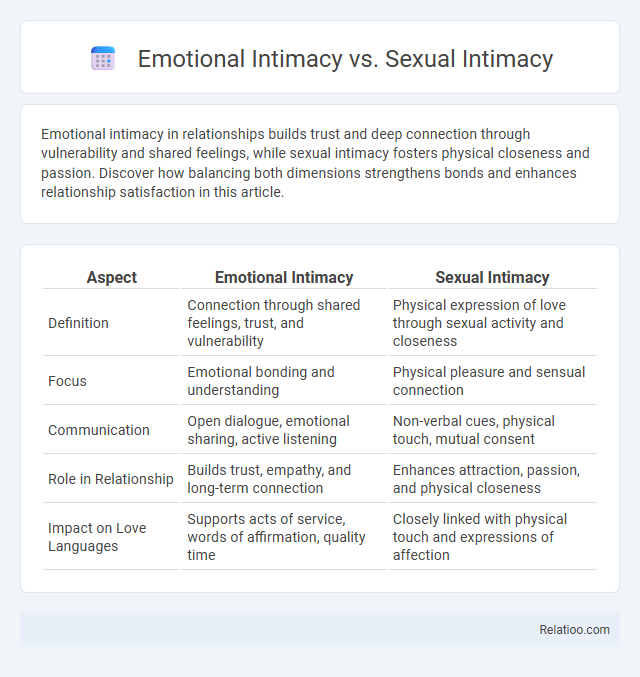Emotional intimacy in relationships builds trust and deep connection through vulnerability and shared feelings, while sexual intimacy fosters physical closeness and passion. Discover how balancing both dimensions strengthens bonds and enhances relationship satisfaction in this article.
Table of Comparison
| Aspect | Emotional Intimacy | Sexual Intimacy |
|---|---|---|
| Definition | Connection through shared feelings, trust, and vulnerability | Physical expression of love through sexual activity and closeness |
| Focus | Emotional bonding and understanding | Physical pleasure and sensual connection |
| Communication | Open dialogue, emotional sharing, active listening | Non-verbal cues, physical touch, mutual consent |
| Role in Relationship | Builds trust, empathy, and long-term connection | Enhances attraction, passion, and physical closeness |
| Impact on Love Languages | Supports acts of service, words of affirmation, quality time | Closely linked with physical touch and expressions of affection |
Understanding Emotional Intimacy
Emotional intimacy involves sharing feelings, thoughts, and vulnerabilities to create a deep sense of trust and connection in relationships, distinguishing it from sexual intimacy which centers on physical and sensual interactions. Developing emotional intimacy requires active listening, empathy, and consistent communication to foster mutual understanding and emotional safety. Lack of emotional intimacy often leads to disconnection, characterized by feelings of loneliness, misunderstanding, and diminished relationship satisfaction.
Defining Sexual Intimacy
Sexual intimacy involves a physical connection and the sharing of desire, pleasure, and vulnerability between partners, distinct from emotional intimacy, which centers on trust, understanding, and emotional bonding. Disconnection occurs when either emotional or sexual intimacy is lacking, causing a rift in the relationship. Your ability to define and nurture sexual intimacy directly impacts the balance and health of your intimate relationships.
Key Differences Between Emotional and Sexual Intimacy
Emotional intimacy involves sharing deep feelings, trust, and vulnerability, creating a strong psychological connection, while sexual intimacy centers on physical closeness and erotic interaction. Disconnection occurs when these forms of intimacy are out of sync, leading to feelings of loneliness or dissatisfaction despite physical or emotional proximity. Understanding the key differences between emotional and sexual intimacy helps you build a balanced relationship that nurtures both heart and body.
Signs of Strong Emotional Intimacy in Relationships
Strong emotional intimacy in relationships is demonstrated through open and honest communication, consistent expressions of empathy, and mutual trust that fosters vulnerability without fear of judgment. Partners exhibit deep understanding of each other's feelings and needs, creating a safe space for sharing personal experiences and emotions. This emotional connection contrasts with sexual intimacy, which centers on physical closeness, and disconnection, characterized by withdrawal and lack of meaningful interaction.
Indicators of Healthy Sexual Intimacy
Healthy sexual intimacy is characterized by open communication, mutual respect, and emotional vulnerability between partners, creating a secure environment for physical connection. Indicators include consistent consent, shared pleasure, and emotional closeness that strengthens overall relationship satisfaction. Recognizing these signs helps differentiate between true intimacy and relationships marked by disconnection or merely physical interaction without emotional bonding.
Why Emotional Intimacy Matters
Emotional intimacy fosters trust, vulnerability, and deeper connection beyond physical interactions, serving as the foundation for lasting relationships. Unlike sexual intimacy, which centers on physical pleasure and attraction, emotional intimacy nurtures understanding and mutual support, essential for relationship stability and satisfaction. Disconnection often arises from a lack of emotional intimacy, leading to feelings of loneliness and decreased relationship quality.
The Role of Sexual Intimacy in Couples
Sexual intimacy plays a crucial role in couples by fostering physical connection, enhancing emotional bonding, and reinforcing mutual trust. While emotional intimacy builds deep understanding and empathy between partners, sexual intimacy often serves as a tangible expression of love and desire that strengthens the overall relationship. Disconnection may arise when sexual needs go unmet or communication breaks down, highlighting the importance of maintaining both emotional and sexual closeness for relationship satisfaction.
Balancing Emotional and Sexual Intimacy
Balancing emotional intimacy and sexual intimacy is essential for a fulfilling relationship, as both contribute to deep connection and satisfaction. Emotional intimacy involves trust, vulnerability, and open communication, while sexual intimacy fosters physical closeness and passion. When you prioritize both aspects, you can prevent disconnection and strengthen the overall bond with your partner.
Common Challenges and Misconceptions
Emotional intimacy often faces challenges such as fear of vulnerability and poor communication, leading to misunderstandings that sexual intimacy alone cannot resolve. Sexual intimacy is frequently misconstrued as a direct indicator of relationship health, overlooking the importance of emotional connection that fosters trust and security. Disconnection typically arises from unresolved conflicts and emotional neglect, creating barriers that affect both emotional and sexual intimacy, resulting in a fragmented relational experience.
Building Lasting Intimacy: Tips for Couples
Building lasting intimacy requires nurturing both emotional and sexual connections, as emotional intimacy fosters trust and vulnerability while sexual intimacy strengthens physical bonds and desire. Couples should prioritize open communication, active listening, and regular expressions of affection to prevent disconnection caused by misunderstandings or neglect. Engaging in shared activities, establishing consistent quality time, and addressing conflicts constructively further reinforce enduring emotional and sexual closeness.

Infographic: Emotional Intimacy vs Sexual Intimacy
 relatioo.com
relatioo.com